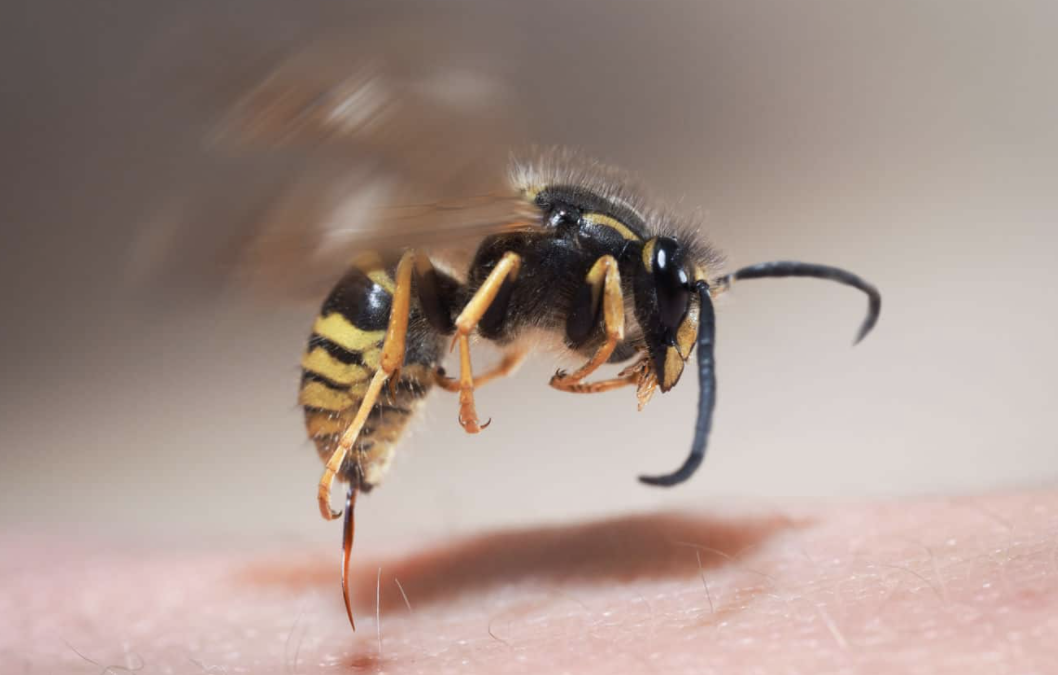Per the HSE, if you get a wasp sting wash the affected area with soap and water. Apply a cold compress, such as a cloth cooled with cold water or an ice pack, to any swelling for at least 10 minutes. raise or elevate the affected area – this can help reduce swelling. Avoid scratching the area or bursting any blisters, to reduce the risk of infection.
HOW TO DEAL WITH A STINGER STUCK IN YOUR SKIN
While a bee can only sting once because its stinger becomes stuck in the skin of its victim, a wasp can sting more than once during an attack. Wasp stingers remain intact. Unless you’re allergic, most bee stings can be treated at home.
After you get stung, look at the sting closely. It’s normal to have a red bump with a black dot in the center. If there’s a small, dark strand sticking out, it’s likely the stinger. You might see a bulbous tip on the top of the strand, which is the venom sac. If you don’t see the stinger, you might worry that it’s stuck under your skin. However,
this is not likely because the barbed shape of the stinger makes it hard for it to get through the skin.
A stinger is also a bee’s “last line of defense”—once it’s used, the bee dies. If you’re looking at the place where you got stung and you see no sign of a stinger,
try to relax. There probably isn’t one, and you were stung by an insect that doesn’t leave a stinger behind.
If you see the stinger, pull the skin around it right so you can get a better look. A taut surface also will make it easier to remove the stinger.
Once you’ve found the stinger, try scraping it off with your fingernail or the edge of a credit card. Avoid using tweezers to remove a stinger, as squeezing it can cause
more venom to release into your skin. If you can’t get the stinger out, don’t panic, it will probably work its way out in a few days, like a splinter would. If the swelling does not go down, you’ll need to see a provider and make sure it’s not infected.
RELIEF
The symptoms will normally improve within a few hours or days, although sometimes they can last a little longer. Some people have a mild allergic reaction and a larger area of skin around the bite or sting becomes swollen, red and painful. This should pass within a week.
HOME REMEDIES
Apple cider vinegar: The theory is that vinegar neutralizes bee sting venom and helps reduce swelling. Try soaking a washcloth in vinegar and placing it on the sting for 15 minutes.
Baking soda: A baking soda paste (1/4 cup baking soda mixed with 1 or 2
tablespoons of water) might help neutralize the sting and reduce
inflammation.
Calamine lotion or hydrocortisone cream: These creams have long been
used to treat itching from different causes, including insect stings.
Honey: Honey has long been used to help with wounds. Ironically, it might
help reduce the swelling from bee stings. It’s also said to kill germs and
speed up healing . 5 Apply just a little honey to the skin where you got stung.
Toothpaste: Toothpaste has said to be a bit of a magical “ointment”. If your
bee or wasp sting is itchy, apply a thin layer of toothpaste to the
affected area. This should be a paste, not a gel toothpaste. This creates a
tingly sensation on your arm which satisfies your urge to scratch the area
while also reducing itchiness.
Topical pain creams: Some products that you put on your skin (topical) are
marketed specifically for bee stings while others are just for relieving pain.
ALLERGIES
Now, if you have an allergic reaction (severe swelling or difficulty breathing). You may need to go to the hospital. If you know you have an allergy to wasp, bee, hornet or yellow jacket stings, always carry a bee sting kit and know how to use it. These kits require a prescription, but in a case where you have swelling to difficulty breathing but don’t know if you have an allergy, call 999 to get help. Some symptoms to look out for are:
Swelling of the lips, tongue, and/or throat
Shortness of breath, wheezing and/or coughing
Full-body itchiness
Hives or swelling beyond the area that they got stung
Reddening of the skin
Runny nose, sneezing, mucus in the throat
Itchy, watery eyes
Stomach cramping, nausea, vomiting, and/or diarrhoea
Feeling lightheaded
High heart rate
Low blood pressure
Passing out

